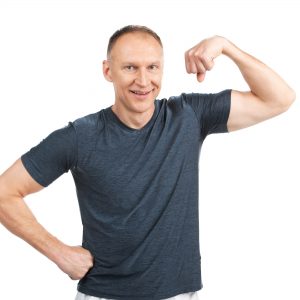New research has suggested that rather than focusing so much on the weight you see when you step on the scales; we need to look into body composition. This means that we need to look at the make up of your weight, for example how much muscle mass and body fat you have in your body. This has been highlighted in research published in the American Journal of Medicine which has shown in older adults that a greater muscle mass may lead to a longer life (1).
Unfortunately as we age we generally start to lose our muscle mass. After the age of 30 this can occur at a rate of around 3–8% reduction in lean muscle mass per decade! This can be for a variety of reasons with a leading cause being the fact that often when we age we become more sedentary. Think about it. Are you as active as you were in your 20s?
How do I gain muscle mass?
The best way to build muscles strength and mass is through completing progressive resistance training exercises, which are also known as strengthening exercises. These types of exercises involve a force being applied against a muscle. The exercises need to be progressive to continue improving. This means increasing the force as the body improves because through continually challenging the body is how you improve.
Examples of exercises
Examples of these exercises include:
- Using free weights- including dumbbells, kettle bells, medicine balls, etc.
- Using body weight- including exercises like squats, push ups, etc.
- Using weight machines such as the leg press machine, chest press machine and weighted cable machine exercises.
How often do I need to resistance train?
This type of training should try to be done 2-3 times a week.
Are there any other benefits?
Building muscle mass is just one of the benefits of resistance training, others include helping with increase/maintain bone density, helping with blood sugar all whilst making performing the activities of daily living easier. It is important to combine these exercises with cardiovascular, balance and flexibility exercises also to get the best overall health. In order to get a resistance training program that’s right for you speak to one of our exercise physiologists or find an exercise physiologist near you.
References
1. Preethi Srikanthan, Arun S. Karlamangla. Muscle Mass Index as a Predictor of Longevity in Older-Adults. The American Journal of Medicine, Volume 127, Issue 6, Pages 547–553, June 2014

